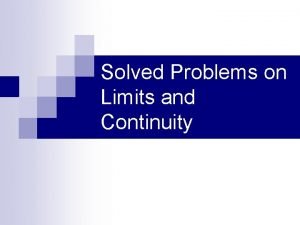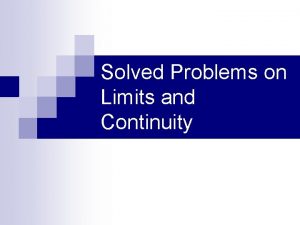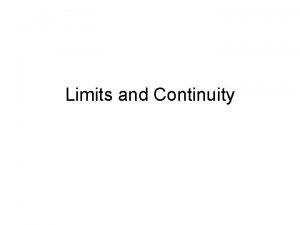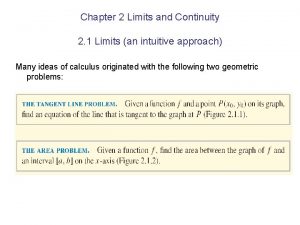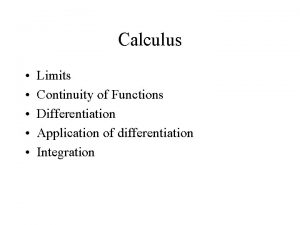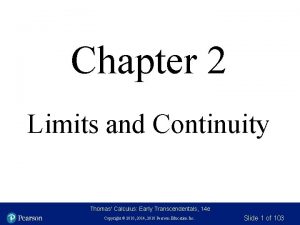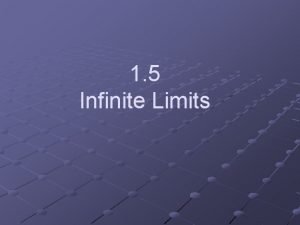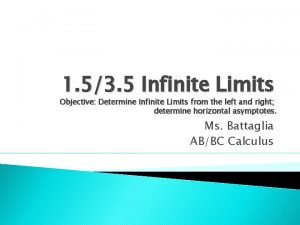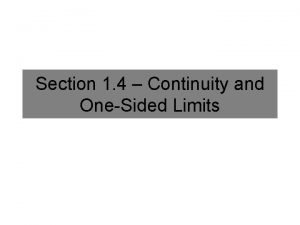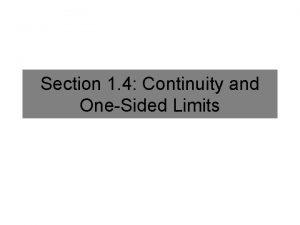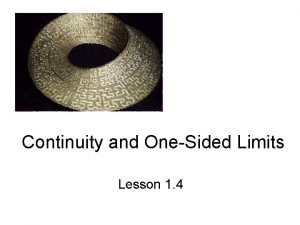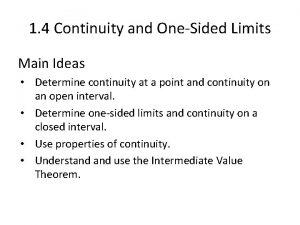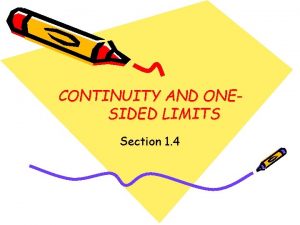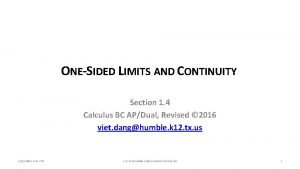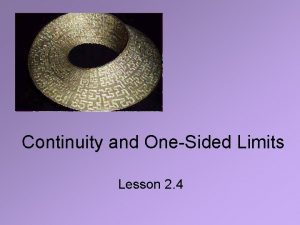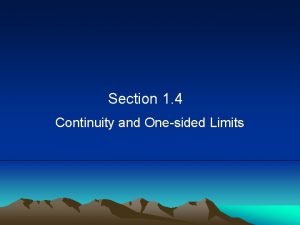1 4 Continuity OneSided Limits 1 Determine continuity










- Slides: 10

1. 4 Continuity & One-Sided Limits 1. Determine continuity at a point and continuity on an open interval. 2. Determine one-sided limits and continuity on a closed interval. 3. Use properties of continuity. 4. Use the Intermediate Value Theorem.

Definition of Continuity • Continuity at a Point: A function f is continuous at c if the following three conditions are met: 1. f(c ) is defined. 2. exists. 3. • Continuity on an Open Interval: A function is continuous on an open interval (a, b) if it is continuous at each point in the interval. A function that is continuous on the entire real line is everywhere continuous.

2 Types of Discontinuity • A removable discontinuity at a point c can be made continuous by appropriately defining (or redefining) the function f at c. • A nonremovable discontinuity occurs if the function f cannot be redefined so that it could be continuous.

One-Sided Limit • The limit from the right (or right-hand limit) of a function f at a point c means that x approaches c from values greater than c. This is denoted as • The limit from the left (or left-hand limit) of a function f at a point c means that x approaches c from values less than c. This is denoted as

Theorem 1. 10 The Existence of a Limit • Let f be a function and let c and L be real numbers. The limit of f(x) as x approaches c is L, if and only if and

Definition of Continuity on a Closed Interval • A function f is continuous on the closed interval [a, b] if it is continuous on the open interval (a, b) and The function f is continuous from the right at a and continuous from the left at b.

Theorem 1. 11 Properties of Continuity • If b is a real number and f and g are continuous at x = c, then the following functions are also continuous at c: 1. Scalar multiple: bf 2. Sum or difference: f ± g 3. Product: fg 4. Quotient: f/g, if g(c) ≠ 0

Continuous Functions • All polynomial functions, rational functions, radical functions, and trigonometric functions are continuous at every point in their domain.

Theorem 1. 12 Continuity of a Composite Function • If g is continuous at c and f is continuous at g(c), then the composite function given by (f o g)(x) = f(g(x)) is continuous at c.

Theorem 1. 13 Intermediate Value Theorem • If f is continuous on the closed interval [a, b], f(a) ≠ f(b), and k is any number between f(a) and f(b), then there is at least one number c in [a, b] such that f(c) = k.
 Real limits vs. apparent limits
Real limits vs. apparent limits Limit involving infinity
Limit involving infinity Limit and continuity solved problems
Limit and continuity solved problems Limits and continuity problems with solutions
Limits and continuity problems with solutions Limits and continuity
Limits and continuity Calculus chapter 2 limits and continuity
Calculus chapter 2 limits and continuity Application of limits and continuity
Application of limits and continuity Thomas calculus limits and continuity
Thomas calculus limits and continuity Determine the infinite limit
Determine the infinite limit Rules for limits to infinity
Rules for limits to infinity Absolute continuity implies uniform continuity
Absolute continuity implies uniform continuity


